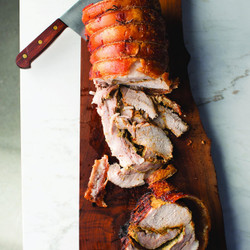Using a very sharp knife or a retractable razor, carefully score the layer of skin and fat in a diamond pattern every ½ inch, cutting through the skin and fat but not into the meat beneath the fat.
Combine the rosemary, sage, oregano, and fennel pollen or fennel seeds in a small bowl.
Using a mortar and pestle, pound the garlic with a pinch of sea salt to a smooth paste. Alternatively, use a micro-plane to finely grate the garlic and stir in the salt.
Lay the pork shoulder flat and generously season with 2 tablespoons of sea salt and the pepper, sprinkling the salt more heavily on the meat than on the fat. Smear the mustard-garlic mixture over the meat and sprinkle with the herb-fennel mixture, massaging it into the pork.
Starting with one of the long sides, roll the meat tightly into a cylinder, with the layer of fat and skin on the outside. Secure the roll with lengths of kitchen twine, tied at 1-inch intervals. Cover with plastic wrap and refrigerate for at least 1 hour and up to two nights.
At least 1 hour before roasting, remove the pork from the refrigerator and let it come to room temperature. About 20 minutes before roasting, preheat the oven to 475 degrees.
Place the pork on a wire rack set inside a roasting pan. Roast until the skin puffs and crisps and takes on a deep amber color, 35 to 45 minutes. Once the skin is golden, lower the temperature of the oven to 300 degrees and continue roasting until the internal temperature reaches 135 degrees, about 2½ to 3 hours total time. Check the temperature after the first 1½ hours of cooking.
Remove the roast from the oven and let it rest, covered loosely with aluminum foil, for 15 to 30 minutes. Carve the porchetta crosswise into thick slices, making sure each slice has a little bit of the cracklings, and serve.
The porchetta can be roasted ahead of time (and then refrigerated) and the individual slices rewarmed in a 350 degree oven for about 5 minutes, until the skin is glistening and crisp. Store leftovers, well wrapped, in the refrigerator for up to 3 days.
